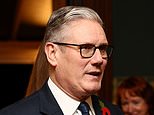
A senior Reserve Bank official says inflation expectations are stabilising – providing a strong hint about likely rate cuts.
The RBA’s assistant governor on economic policy, Sarah Hunter, noted that ‘expectations feed into actual inflation outcomes’.
She said financial markets were expecting inflation to fall at a faster pace than RBA models had predicted.
‘There’s no evidence of expectations being more persistent than normal,’ she told the Citi Australia and New Zealand Investment Conference in Sydney on Wednesday.
‘There’s even some evidence of households and unions extrapolating less from recent inflation, at least during the period of higher inflation.’
Dr Hunter said low and stable inflation was ‘critical to preserving macroeconomic stability’ – adding this would make businesses less likely to pass on higher costs on to customers.
‘Volatility breeds uncertainty, and uncertainty makes decisions harder for everyone,’ she said.
‘As a business, how do you decide when it’s right to invest if you’re less sure of the financial returns?’
Dr Hunter’s speech is a sign the Reserve Bank is now more open-minded about cutting rates, with the RBA having considered another hike as recently as August.
RBA assistant governor (economic) Sarah Hunter has told an investment conference inflation expectations are stabilising and easing
Stablising inflation could also make unions less likely to push for even higher wages.
‘This could be workers, or their union representatives, bargaining for higher wages if they think inflation will be higher,’ she said.
Financial markets are optimistic about the rate cuts next year, and the major banks are predicting four in 2025.
‘When it comes to how inflation expectations feed into long-term interest rates, it’s the financial markets’ expectations that matter,’ Dr Hunter said.
The 30-day interbank futures market is expecting the Reserve Bank to start cutting rates in March, from an existing 12-year high of 4.35 per cent.
Four quarter-point cuts in 2025 would take the cash rate back to 3.35 per cent for the first time since March 2023 – partially unwinding the RBA’s 13 increases in 2022 and 2023.
New Zealand has already cut its central bank cash rate twice this year.
Financial markets are optimistic about the rate cuts in the longer term and the major banks are predicting four in 2025 (pictured are Sydney shoppers)
But Reserve Bank Governor Michele Bullock has repeatedly stressed there would be no rate cuts in 2024, despite the US, UK, Canada, New Zealand and the EU already cutting rates this year.
Australia’s underlying inflation rate – with big price movements taken away – is still above the Reserve Bank’s 2 to 3 per cent target.
In August, the trimmed mean measure of inflation showed an annual increase of 3.4 per cent.
But the consumer price index, otherwise known as headline inflation, dropped to 2.7 per cent, which was a sharp fall from 3.5 per cent in July.
This was the lowest monthly headline inflation rate since August 2021 when Sydney and Melbourne were still in lockdown.
Dr Hunter’s remarks offer some hope that the RBA could cut interest rates with inflation appearing to be more subdued
The fall, however, was largely a result of the federal government’s $300 energy rebates that came into effect on July 1, along with generous state government electricity relief programs.
Petrol prices had also fallen by 7.6 per cent over the year, however the price of fuel is inherently volatile and may soon rise just as quickly.
Ms Bullock warned a big fall in headline inflation – which includes volatile price items – would not lead to a rate cut in 2024 because fuel price dips and subsidised energy prices were temporary.
Westpac chief economist Luci Ellis, a former assistant governor at the Reserve Bank, said central bank interest rates were likely to be higher in the 2020s than they were in the 2010s, even with the expected rate cuts next year.






